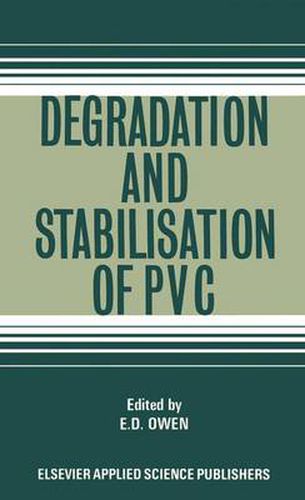Readings Newsletter
Become a Readings Member to make your shopping experience even easier.
Sign in or sign up for free!
You’re not far away from qualifying for FREE standard shipping within Australia
You’ve qualified for FREE standard shipping within Australia
The cart is loading…






This title is printed to order. This book may have been self-published. If so, we cannot guarantee the quality of the content. In the main most books will have gone through the editing process however some may not. We therefore suggest that you be aware of this before ordering this book. If in doubt check either the author or publisher’s details as we are unable to accept any returns unless they are faulty. Please contact us if you have any questions.
Polyvinyl chloride has played a key role in the development of the plastics industry over the past 40 years and continues to be a polymer of major importance. The reasons for its enormous versatility and range of application derive from a combination of the basic structure which gives rise to a relatively tough and rigid material and its ability to accept a range of plasticisers and other additives which can modify its physical characteristics to produce a range of flexible products. Two major problems, however, have tested the skill and ingenuity of PVC technologists since earliest times. One is the thermal instability of the material at the temperatures required for melt processing and fabrication, and the second is the photochemical instability which until recently has limited the potentially large range of outdoor applications. Both problems have been handled in a commercially satisfactory way by the gradual development of a range of stabilisers, lubricants and other processing aids and the high quality material which has resulted has led to massive utilisation of PVC by industry. Totally adequate stabilisation requires a detailed understanding of the mechanisms by which degradation processes are initiated and propagated. Although great advances have been made in this respect in recent years the problem remains incompletely understood. This book presents an account of the present position and the problems which remain to be solved.
$9.00 standard shipping within Australia
FREE standard shipping within Australia for orders over $100.00
Express & International shipping calculated at checkout
This title is printed to order. This book may have been self-published. If so, we cannot guarantee the quality of the content. In the main most books will have gone through the editing process however some may not. We therefore suggest that you be aware of this before ordering this book. If in doubt check either the author or publisher’s details as we are unable to accept any returns unless they are faulty. Please contact us if you have any questions.
Polyvinyl chloride has played a key role in the development of the plastics industry over the past 40 years and continues to be a polymer of major importance. The reasons for its enormous versatility and range of application derive from a combination of the basic structure which gives rise to a relatively tough and rigid material and its ability to accept a range of plasticisers and other additives which can modify its physical characteristics to produce a range of flexible products. Two major problems, however, have tested the skill and ingenuity of PVC technologists since earliest times. One is the thermal instability of the material at the temperatures required for melt processing and fabrication, and the second is the photochemical instability which until recently has limited the potentially large range of outdoor applications. Both problems have been handled in a commercially satisfactory way by the gradual development of a range of stabilisers, lubricants and other processing aids and the high quality material which has resulted has led to massive utilisation of PVC by industry. Totally adequate stabilisation requires a detailed understanding of the mechanisms by which degradation processes are initiated and propagated. Although great advances have been made in this respect in recent years the problem remains incompletely understood. This book presents an account of the present position and the problems which remain to be solved.